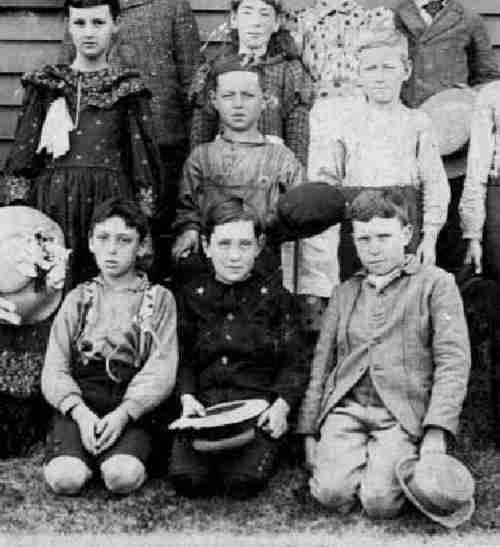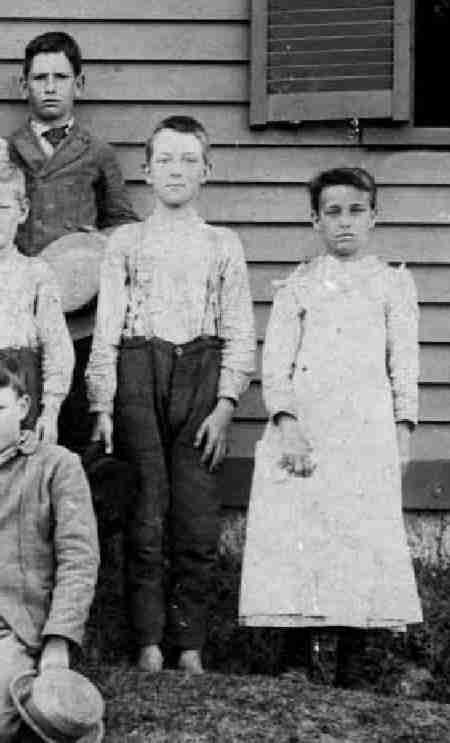
Figure 1.--These 8 and 9 years olds were probably in the 3rd or 4th grade. They wear quite a variety of outfits.


Figure 1.--These 8 and 9 years olds were probably in the 3rd or 4th grade. They wear quite a variety of outfits. |
HBC has one image from the 1985 Grafton "farm school". The children lokk to be about the same age, 8-9 years. So they
appear to be one class from a larger schoool. Children that age would be in the 3rd or 4th grade. The boys here have their hats
which is relatively wear in these portraits.
This appears to be a 3rd or 4th grade class as we actually have a list of some of the children in the photograph indicating that they are 8 or 9 years old. There is, however, one 11-year old boy. In front row are Walter Buxton age 11, Carl Flagg age 9 and Charlie Wynott age 8. Middle row is Clara Buxton age 8 in dark dress and hat, John Gammon age 9, behind Clara, Nellie Atchue is in white dress. Walter henry (blond), Lew Henry Walter's brother and Harold Rice. In back row are
Gamon sisters, Claire Lougee and Charlie Whitney.
Readers may find other HBC sections of interest in evaluating the fashions that the boys were wearing in the 1890s.
The 1890s or Gay 90s were a fascinating decade. The world still centered on glitering Europe. The Europe of the late 19th century seemed so fixed, so permanent. Style was still set by the European monarchies-- but they were rapidly approaching the catoclism of the 20th century, the Great War that few would survive. But for the 1890s Europe
gleamed and America looked to Europe for style and elegance. Despite the political stability of the late 1890s, change was in fact everwhere--especially in America. Horse and buggies were being replaced by automobiles, gas lamps with electrical light bulbs. America was rapidly moving toward its rendezvous with destiny and the century which was to
become, in so many ways, the American century. America was changing from subsistence agriculture, log cabins, and rail splitting to industrial manufacturing, rail roads, and international trade. The industrial giant that was to save western
democracy and the free world had begun to emerge.
Little American boys from 3 to 6 years, in the late 19th Centuery still wore skirted garments. Little boys wore dresses,
although now dresses especially designed for boys appeared. Older boys wore kilts, sailor suits, Norfolk suits and other English fashions. Smocks were used for both boys and girls to protect expensive clothes, although they were not as popular as in Europe. Easy to care for fabrics were generations away. One new fashion appearing in America in the the 1880s was the Fauntleroy suit. It was the sailor suit, however, that proved to be most enduring of these fashions. It was popular with both mothers and boys, unlike some of the alternatives like Fauntleroy suits and kilts. Even girls in the 1880s began wearing sailor suits, middy blouses with skirts.
Mail order catalogs in the 1890s provide a valuable record of the sshions worn as the age of the boys wearing them as well as other details such as finishing and materials. Mail order catalogs offered a variety of clothes for boys in the 1890s, including dresses, kilt suits, Fauntleroy suits and blouses, sailor suits, and kneepats and long pants suits as well as a wide range of accessories.

Figure 2.--TOne boy in this photograph wears a suit while another wears bib-front overalls. Notice the huge wide-beimmed hat worn by one girl. |
The children at the school wear quite a variety of outfits. Note the differents. One boy wears bib overalls while three other boy wears a suit. Two boys wear plain shirts and suspenders. One interesting observation is even though sailor suits were all the rage for boys, none of these boys wears one. Perhaps the fact that this was a rural school made the sailor suit style less common.
Boys and girls in the 19th century commonly wore hats. Caps became more common after the turn of the century, but hats were still very common in 1890s. Note for example the huge hats that the girl at the left wears. The boys at the front have their generally narrow-brim hats.
Three of the boys wear suits. It is a little hard to tell, but two of the suits appear o be dounle breasted. One boy wears long pants with his suit, but I'm not sure what the other boys in suits are wearing.
One boy wears a blavk outfit, but it is not possible to make out much of the detail. It has many buttons and is buttoned at the collar, but I just can't make out what type og garment it is.
Sailor suits were extrmely popular in the 1890s. I'm not sure why none of these boys is wearing one. We rather suspect that sailor suits were not as popular in rural areas.
Notice that none of the boys are wearing kilt suits which had been an important fashion for younger boys. Despite being widely worn for dresswear, it does not seem to be a garment that boys wore to school. In addition these boys are slightly older than the age at which boys wore kilt suits. HBC believes that kilt suits like sailor suits were less common in rural schools.
The boys appear to be wearing plain shirts with simple collars. One boy wears a waist with no collar. They appear to be white shirts, but two boys wear colored shirts. I'm not sure what color.

Figure 3.-- |
This appears to have been rather an informal school. Two of the boys in suits wear open-collar shirts. Only one boy wears a bow and it is realively small. It was quite fashionable for boys in the 1890s to wear very large bows. Again this may be a function of the more causual, less fashionable styles in rural communities.
AIt is not possible to determine what many of the boys are wearing. One boy oviously wears kneepants. Two boys obviously wear long trousers. It is not possible to detrmine wjat the other boys are wearing.
It is not possible to determine what kind of hosiery these boys are wearing.
t is not possible to determine what kind of shoes these boys are wearing. At least one boy appears to be barefoot.
All the girls wear dresses. Several wear white pinafores with their dresses. I'm not sure what the conventions were as to which girls wore pinafores. Whether these were the more affluent or least affluent children.
The children at the school clearly dresses up for school. HBC is not sure, however, if they were especially done up for the photograph or if this is how they normally came to school.

Figure 4.-- |
One interesting question is what the boys' thought of these outfits. One suspects thatr the boys with ruffled collars might have objected somewhat. Presumably the sailor suits were much more popular with the boys. HBC hopes to eventually acquire some accounts offrom memories with men remembering their boyhood.
Notice that all of these boys have short hair cuts. Some Little Lord Fauntleroy suits were worn with long ringlet curls. Clearly atr the Grafton school, even the boys with Fauntleroy ruffled collars wore short hair styles. This is a good indicator that boys with ringlet curls above the ages of 5 or 6 years were boys that were not sent to public schools.
Related Chronolgy Pages in the Boys' Historical Web Site
[Main Chronology Page]
[The 1900s]
[The 1910s]
[The 1920s]
[The 1930s]
[The 1940s]
[The 1950s]
[The 1960s]
[The 1970s]
[The 1980s]
[The 1990s]
[The 2000s]
Navigate the Relate Boys Historical Clothing Style Pages
[Main country page]
[Long pants suits]
[Short pants suits]
[Lederhosen]
[Kneesocks]
[Eton suits]
[Jacket and trousers]
[Blazer
[School sandals]
Navigate the Boys' Historical Clothing School Uniform Pages
[Main Grafton School page]
[Main National School Uniform Page]
[Australia]
[England]
[France]
[Germany]
[Ireland]
[Italy]
[Japan]
[New Zealand]
[Poland]
[Singapore]
[Scotland]
[Singapore]
Navigate the Boys' Historical Clothing Web Page
[Introduction]
[Activities]
[Bibliographies]
[Biographies]
[Chronology]
[Clothing styles]
[Contributions]
[Countries]
[Boys' Clothing Home]
